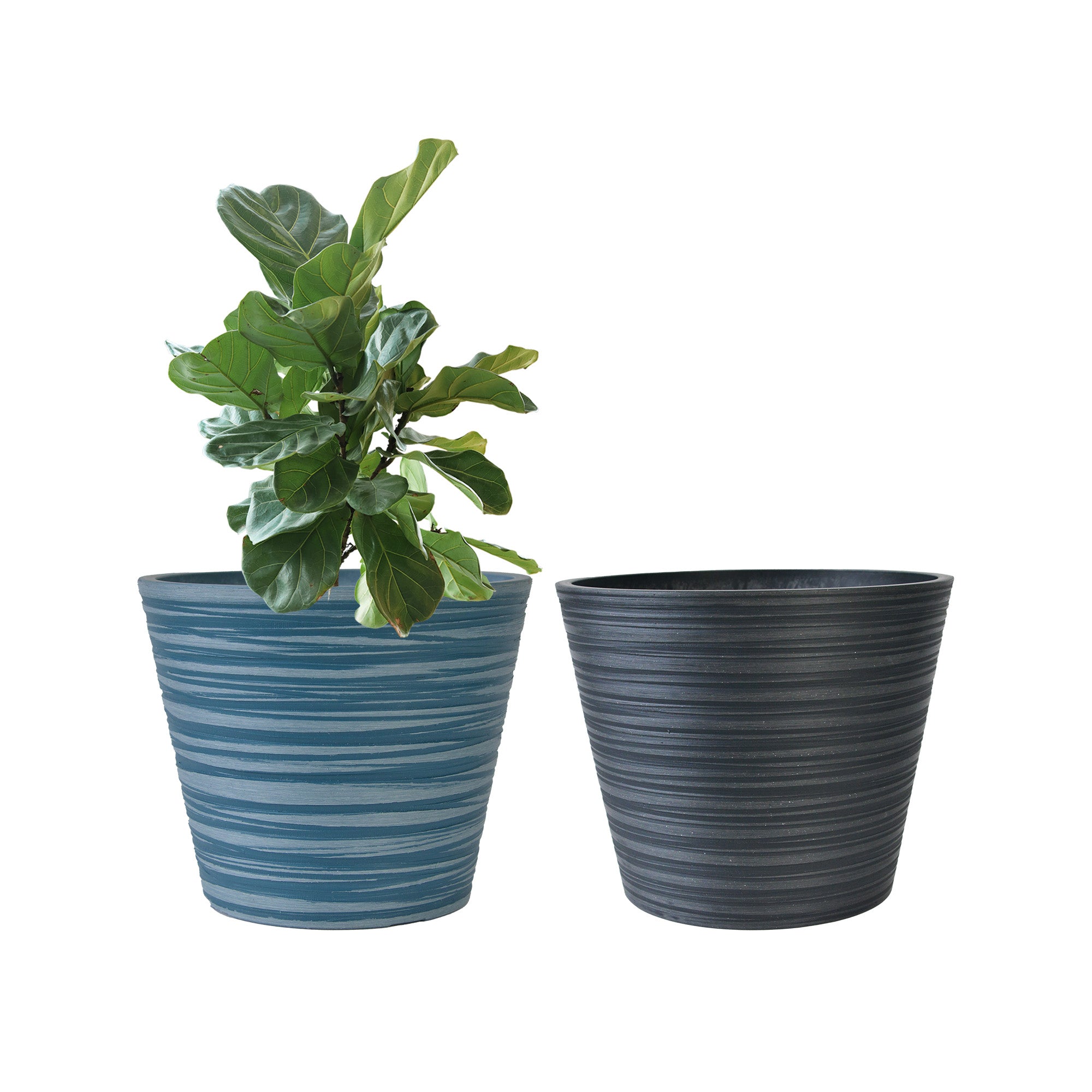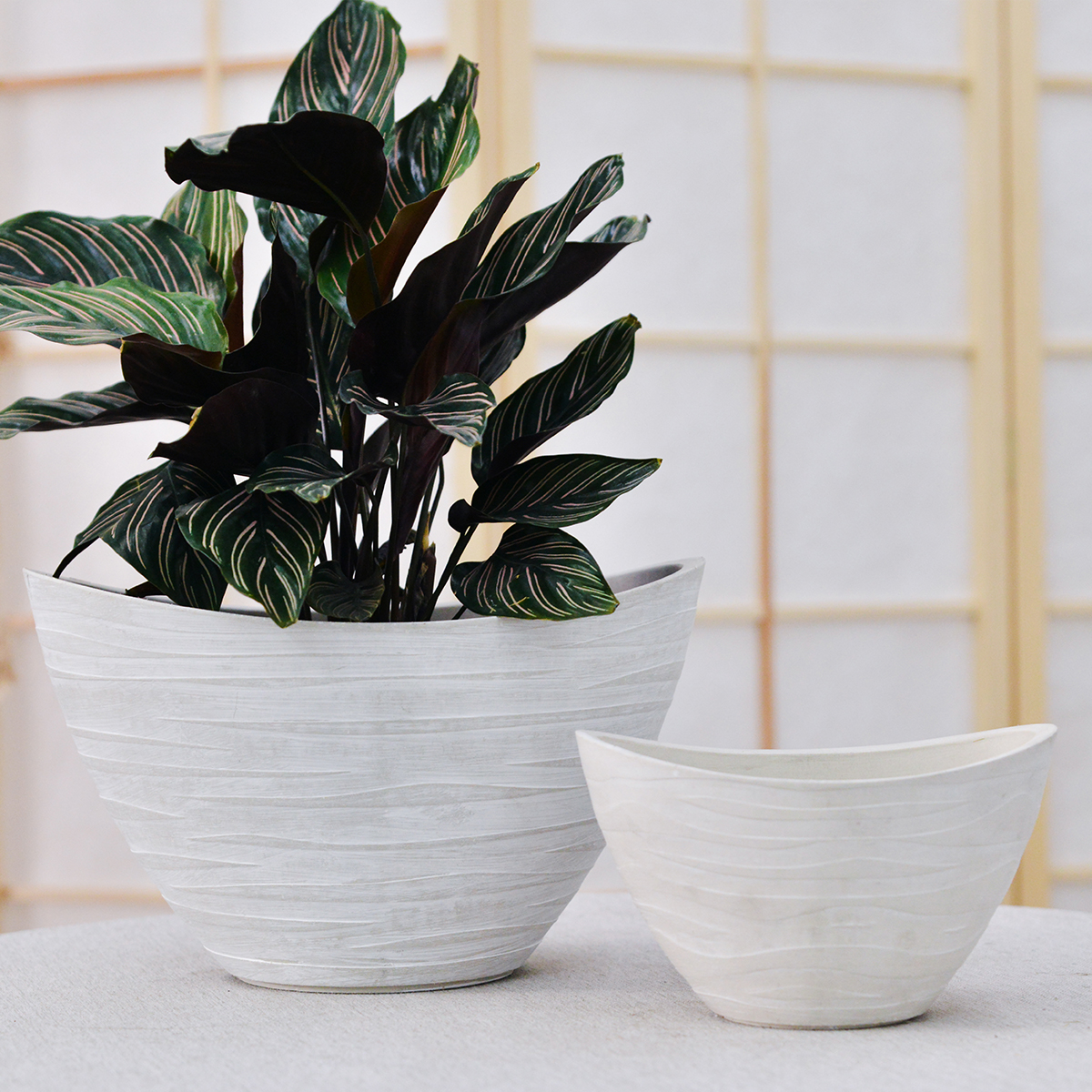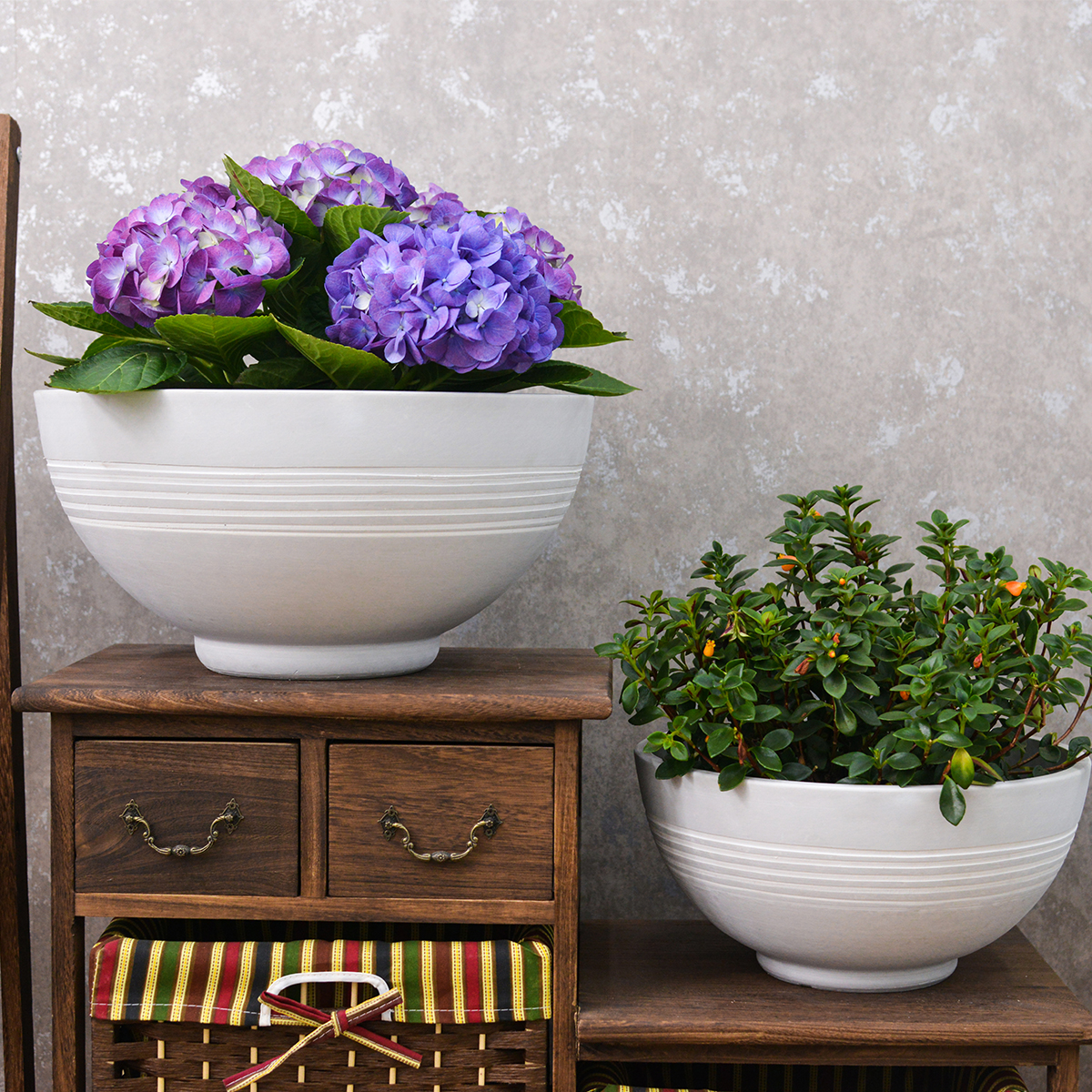Clematis in Pots: The Complete Guide to Growing Clematis Outdoors in Containers (Fragrant & Stunning Blooms!)
Want to add vertical interest and a cascade of breathtaking blooms to your patio, balcony, or garden? Growing Clematisin containers is a wonderfully rewarding way to bring these spectacular flowering vines into your outdoor spaces. Celebrated for their stunning, star-shaped flowers in a wide array of colors and forms, their vigorous climbing habit, their relatively long blooming season, and their adaptability to container gardening, Clematis is perfect for creating vertical beauty and adding a touch of romantic elegance to your outdoor living areas. This comprehensive guide will provide you with everything you need to know to grow Clematis successfully in outdoor pots, from selecting the best varieties and containers to mastering essential care techniques for a stunning and fragrant display.
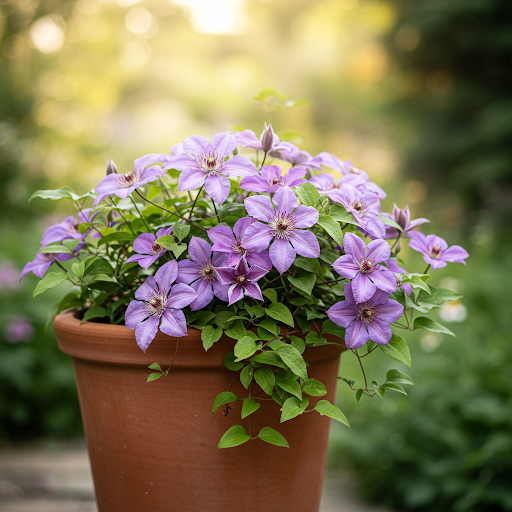
Clematisin
What is Clematis?
Clematis is a genus of mostly vining, flowering plants in the buttercup family (Ranunculaceae). With hundreds of species and thousands of cultivars, they are popular ornamental plants in gardens worldwide, prized for their beautiful and diverse flowers, climbing habit, and versatility in garden design. Clematis vines are characterized by their twining leaf petioles that act as tendrils, allowing them to climb supports, opposite leaves, and showy flowers with prominent sepals (petal-like structures) in various shapes and sizes. Flowers come in a vast spectrum of colors, including purple, blue, pink, red, white, yellow, and bi-colors. They exhibit a wide range of growth habits, from compact, shrubby types to vigorous climbing vines, making them suitable for various garden uses, including trellises, walls, fences, and containers. Clematis are known for their diverse flower forms (single, semi-double, double, bell-shaped), their long blooming season (depending on variety), and their ability to attract pollinators like bees and butterflies.
Is Clematis Good for Outdoor Pots?
Yes, Clematis is well-suited for outdoor pots and container gardening, and is a popular choice for adding vertical interest and beautiful blooms to patios, balconies, and other paved areas. Their adaptability to pruning, manageable size in containers (especially certain types), prolific flowering, and climbing habit make them ideal for container cultivation. Growing Clematis in pots offers several advantages:
- Ideal for Small Spaces: Container gardening allows you to enjoy clematis even if you have limited garden space, such as on balconies, patios, or decks.
- Vertical Gardening: Clematis are natural climbers and thrive when given vertical support in containers, adding height and visual interest to small spaces.
- Portability: Potted Clematis can be easily moved to optimal locations for sunlight, display, or shelter from extreme weather. You can rearrange them to create stunning focal points or seasonal displays.
- Controlled Environment: Container gardening allows you to provide the specific well-draining, fertile soil mix that Clematis prefers and control watering and fertilization more precisely, which is important for their health and flowering.
- Design Versatility: Clematis in pots can be used as standalone specimen plants with a trellis in the pot, trained against walls or fences, or used to soften the edges of patios and balconies.
- Pest and Disease Management: Container growing can help reduce some soilborne pest and disease issues that can affect Clematis planted directly in the ground.
Ideal Growing Conditions for Clematis in Pots:
Types of Clematis for Pots: While many Clematis can be grown in containers, some are more suitable than others due to their size and growth habit:
- Patio Clematis: Bred specifically for containers, Patio Clematis are compact, bushy, and floriferous, reaching about 3-5 feet tall. They are excellent for pots and smaller spaces and don’t require extensive climbing support.
- Compact or Bush Clematis: Look for Clematis varieties described as “compact,” “bushy,” or “non-climbing.” These tend to be smaller and more manageable in pots. Examples include Clematis alpina, Clematis macropetala and their cultivars, and Clematis viticella cultivars.
- Viticella Clematis: Viticella types are generally vigorous and disease-resistant, but are often more manageable in size than some of the large-flowered hybrids. They are also very free-flowering and bloom later in the season.
- Early/Mid-Season Large-Flowered Clematis (Select Varieties): Some of the early and mid-season large-flowered hybrids can be grown in large containers, but choose less vigorous varieties and be prepared for regular pruning. Look for varieties that are described as being suitable for containers or smaller gardens.
Light: Clematis generally thrive in full sun to partial shade. Most varieties prefer at least 6 hours of sun per day, especially for flowering. For container planting, morning sun and afternoon shade can be ideal, especially in hotter climates, as it helps to keep the roots cool. Some varieties, particularly the more delicate, pastel-colored blooms, may benefit from some protection from the hottest afternoon sun to prevent fading. Darker colored varieties are generally more sun-tolerant. Ensure the roots are shaded and kept cool, even if the foliage is in sun (see “Root Shade” below).
Soil: Clematis needs well-draining, fertile soil that is rich in organic matter and retains moisture. Use a high-quality potting mix specifically formulated for контейнер plants or flowering vines, or a premium general-purpose potting mix amended for Clematis. Amend potting mix with compost, well-rotted manure, and peat moss or coco coir to improve fertility, drainage, and water retention. Good drainage is crucial to prevent root rot, especially in containers. Clematis prefer neutral to slightly alkaline soil with a pH of around 6.5-7.0.
Watering: Clematis needs consistent moisture, especially when actively growing and blooming in containers. Water deeply and regularly, especially during dry periods and hot weather. Water thoroughly when the top inch of soil feels slightly dry. Water deeply until water drains out of the drainage holes. Then, allow the topsoil to slightly dry before watering again. Avoid overwatering and consistently soggy soil, but also avoid prolonged drought stress, which can weaken plants and reduce flowering. Container-grown plants will dry out faster than those in the ground, so monitor soil moisture regularly. Water more frequently during hot, sunny weather and peak bloom. Water less frequently during cooler, cloudier periods and in winter dormancy.
Temperature: Clematis are generally hardy in a wide range of temperate climates. They prefer moderate temperatures during the growing season and need a period of winter dormancy with some chill hours to bloom well. In Singapore’s consistently warm climate, temperature is generally suitable for Clematis, though they may benefit from some afternoon shade during the hottest periods. Ensure good air circulation, especially in humid climates like Singapore, to help prevent fungal diseases.
Humidity: Clematis prefer moderate humidity. High humidity can increase the risk of fungal diseases like Clematis wilt and powdery mildew. Ensure good air circulation around potted clematis, especially in humid climates like Singapore, by spacing pots adequately and choosing open locations.
Fertilizer: Clematis are moderate feeders and benefit from regular fertilization to support their vigorous growth and abundant flowering, especially when grown in containers. Fertilize monthly during the active growing and blooming season (spring through summer). Use a balanced liquid fertilizer (e.g., 20-20-20 or 10-10-10) diluted to half strength, or a fertilizer specifically formulated for flowering vines or roses. Follow product label instructions for Clematis. A fertilizer slightly higher in potassium (the last number) can encourage better flowering and disease resistance. You can also amend the soil with bone meal at planting time to provide phosphorus, which encourages flowering. Avoid high-nitrogen fertilizers, which can promote leafy growth at the expense of flowers. Stop fertilizing in late summer or early fall to allow plants to prepare for dormancy.
Root Shade: Clematis roots prefer to be kept cool and shaded, even if the tops of the plants are in full sun. This is crucial for their health and flowering. When planting Clematis in containers, ensure the pot itself provides shade to the root zone, or use mulch or companion plants to shade the base of the plant and the pot. You can use mulcharound the base of the Clematis in the pot (such as bark chips or pebbles) to keep the soil cool and retain moisture. You can also plant shallow-rooted annuals or perennials around the base of the Clematis in the pot to provide shade to the roots.
Choosing the Right Pots for Clematis:
Suitable Pot Types: Clematis needs pots that are deep, wide, and provide good drainage and insulation for the roots. Suitable pot types include:
- Terracotta Pots: Large terracotta pots are a good choice as they are porous, allowing for good aeration and drainage, and provide insulation to keep roots cooler in summer and warmer in winter. Choose thick-walled terracotta pots. Larger, heavier terracotta pots are recommended for stability, especially for larger Clematis vines and support structures.
- Ceramic Pots: Glazed or unglazed ceramic pots can be used, offering a wide range of decorative styles and good insulation. Ensure they are frost-proof if needed in your climate and have drainage holes. Choose sturdy, thick-walled ceramic pots.
- Wooden Containers: Wooden planters or half-barrels provide excellent insulation and a natural look. Ensure they are treated to prevent rot and have good drainage.
- Resin Pots (High Quality): High-quality, thick-walled resin pots can be used, especially for larger plants, as they are lighter than terracotta or ceramic of the same size, but still provide good insulation and durability. Choose UV-resistant and frost-proof resin pots if needed. Avoid thin plastic pots.
Drainage: Excellent drainage is absolutely essential for Clematis to prevent root rot. Ensure your chosen pot has multiple drainage holes at the bottom. Avoid pots without drainage holes. Always use a generous drainage layer at the base of the pot (e.g., a thick layer of gravel or pot shards) beneath the potting mix to further enhance drainage. Elevating pots slightly on pot feet or bricks can also improve drainage and air circulation.
Pot Size: Choose pot sizes appropriate for the type of Clematis and its mature size. Clematis needs sufficient root space to thrive and bloom well.
- Minimum Pot Size: A minimum pot size of 18 inches in diameter and 18 inches deep is recommended for most Clematis varieties.
- Ideal Pot Size: For larger, more vigorous Clematis or for long-term container growing, aim for pots that are 20-24 inches in diameter and 20-24 inches deep or larger. The larger the pot, the better for root development, moisture retention, and overall plant health.
- Depth: Pots should be at least 18-24 inches deep to accommodate the deep root system of Clematis. Deeper pots are generally better than shallow, wide pots.
Stability: Clematis vines can become quite substantial, especially when trained on a trellis or support. Stability is a crucial consideration, especially for outdoor containers exposed to wind. Choose heavy pots made of terracotta, ceramic, wood, or heavy-duty resin. Wider pots are generally more stable than tall, narrow pots. Ensure the pot is stable enough to support the weight of the mature vine and trellis, and to prevent toppling in wind.
Color and Material (Root Temperature): Choose pot colors and materials that help keep the roots cool, especially in hot climates. Lighter colored pots (pale terracotta, light-colored ceramic, light wood tones, light resin) will absorb less heat than dark pots. Thick-walled pots made of terracotta, ceramic, or wood provide better insulation than thin plastic. Avoid dark plastic pots, which can heat up excessively in full sun and overheat the roots.
Support Integration: Consider pots that can integrate a trellis or support structure easily, or choose pots that are wide and stable enough to accommodate a separate trellis or obelisk inserted into the pot.
Essential Care Tips for Thriving Clematis in Outdoor Pots:
- Watering: “Water Regularly, Allow Topsoil to Slightly Dry Between Waterings”. Water deeply and regularly during the growing season, especially in dry periods. Allow topsoil to slightly dry between waterings. Avoid overwatering and soggy soil. Water at the base of the plant, avoiding wetting foliage excessively.
- Sunlight: Provide Full Sun to Partial Shade (at least 6 Hours of Sun, Shade Roots). Place Clematis pots in a location with full sun to partial shade outdoors. Ensure roots are shaded and kept cool. Morning sun and afternoon shade is often ideal.
- Pruning (Varies by Clematis Type – Know Your Variety): Pruning requirements vary significantly depending on the Clematis variety and bloom group. Determine the pruning group of your Clematis variety (Group 1, 2, or 3)and prune accordingly. Generally, early-flowering types (Group 1) require minimal pruning, while large-flowered hybrids (Group 2) and late-flowering types (Group 3) benefit from more regular pruning. Prune at the correct time of year for your specific type to maximize flowering.
- Support: Provide Strong Trellis, Obelisk, or Wall Support. Provide a sturdy support structure at planting time for Clematis to climb.
- Fertilizing: Fertilize Monthly During Growing Season with Balanced Liquid Fertilizer. Fertilize regularly during the spring and summer growing season to promote healthy growth and abundant flowering. Use a balanced liquid fertilizer or rose fertilizer.
- Root Shade: Keep Roots Cool and Shaded. Mulch around the base of the plant in the pot and/or use companion plants to shade the roots and pot.
- Winter Care (Protect in Cold Climates): In Singapore, no winter protection is needed. In regions with cold winters, provide winter protection for potted clematis. This may involve moving pots to a sheltered location (garage, unheated greenhouse), wrapping pots to insulate the roots, or mulching heavily around the base. Check specific winter care needs for your climate and Clematis variety.
- Pest and Disease Control (Monitor and Prevent): Monitor Clematis regularly for common pests and diseases, such as aphids, spider mites, Clematis wilt, and powdery mildew. Good air circulation, proper watering, and healthy plants are the best defense. Treat promptly with appropriate insecticides or fungicides if issues arise.
Popular Clematis Varieties for Pots (by Type and Color):
- Patio Clematis (Compact): ‘Bijou’ (pink), ‘Taiga’ (double blue-purple), ‘Little Bas’ (purple-red), ‘Sugar-Sweet Blue’ (blue).
- Compact/Bush Clematis (Non-Climbing or Short Climb): Clematis alpina and macropetala varieties (early spring bloom, bell-shaped flowers, various colors), Clematis integrifolia varieties (non-climbing, herbaceous, various colors), Clematis heracleifolia ‘Wyevale Dream’ (fragrant, hyacinth-like flowers, non-climbing).
- Viticella Clematis (Vigorous, Late Blooming, Manageable): ‘Étoile Violette’ (deep purple), ‘Polish Spirit’ (violet-blue), ‘Madame Julia Correvon’ (red-pink), ‘Purpurea Plena Elegans’ (double purple-magenta).
- Early/Mid-Season Large-Flowered Hybrids (Select Compact Varieties): ‘Nelly Moser’ (pink with pink stripe), ‘Asao’ (pink with darker pink stripe), ‘Henryi’ (white), ‘Jackmanii’ (purple, classic, vigorous, but can be pruned to container size).
In Summary:
Growing Clematis in outdoor pots is a wonderfully rewarding way to create vertical beauty and enjoy the stunning blooms of these elegant vines, even in limited spaces. By selecting suitable, more compact Clematis varieties, providing full sun to partial shade (with shaded roots), well-draining, fertile potting mix in large, insulated pots with excellent drainage and stability, regular watering and fertilization during the growing season, consistent pruning (according to variety type), and sturdy support for climbing, you can easily cultivate thriving and spectacularly blooming Clematis plants in pots and enjoy their breathtaking floral displays and vertical elegance in your outdoor living spaces for years to come.
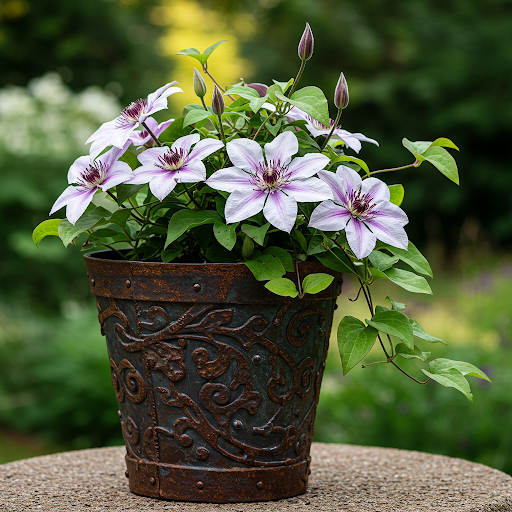
Clematis
For more detailed botanical information and to explore the diverse world of Clematis, you can visit the Wikipedia page on Clematis.
Important Note: The key to success with Clematis in pots is providing ample sunlight to the tops while keeping the roots cool and shaded, ensuring excellent drainage to prevent root rot, consistent watering and feeding during the growing season, and understanding the pruning needs of your specific Clematis variety. With proper care and attention to their specific needs, your potted Clematis will reward you with a spectacular vertical display of exquisite blooms and add a touch of romantic elegance to your outdoor container garden!
KC3-14A
By greenship|2024-08-16T06:26:30+00:00August 16, 2024|Categories: Hand-carving Series|
Planter 5 in W / 8 in W / 12 in W or Indoor Outdoor Plants, Modern Decorative Plant Pots with Drainage Hole, Decorative Flower Pots
By greenship-seo|2025-04-10T06:37:58+00:00January 16, 2025|Categories: Hand-carving Series|Tags: Decorative Flower Pots|
KC2-21G
By greenship|2024-08-13T06:19:08+00:00August 13, 2024|Categories: Hand-carving Series|
Modern Plant Pots with Drainage – Indoor & Outdoor Use (6″ Widths)
By greenship-seo|2025-04-10T06:29:43+00:00February 6, 2025|Categories: Hand-carving Series|Tags: Decorative Flower Pots|
20YB
By greenship|2024-08-16T05:37:57+00:00August 16, 2024|Categories: Hand-carving Series|
KC3-09k
By greenship|2024-08-16T06:24:36+00:00August 16, 2024|Categories: Hand-carving Series|


